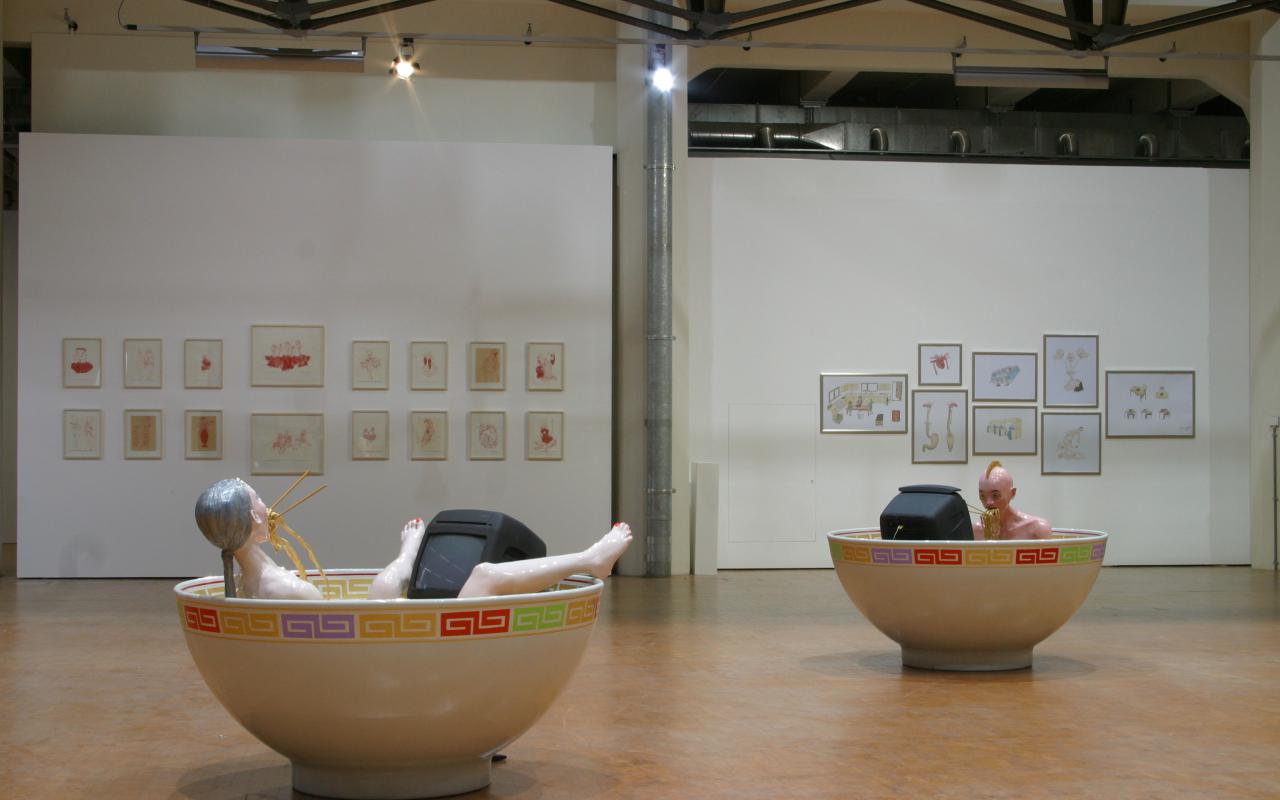
»The banquet. Metabolism and Communication« exhibition uses examples of communication to shed light on the change from close society to remote society. In the close society, communication was for millennia bound to a specific location. . In enclosed communities, tribal villages, houses, castles, and courts a closed communication cycle emerged. Ever since Platos symposium, the table has formed the venue of discussion and a meal taken together has been the center of social life and a preferred model for close communication. This banquet situation is an example for the analogy of nutritional cycle and communication cycle, between the exchange of food and that of information, between metabolism and communication.
The exhibition presents different standpoints and perspectives of an extended metaphor for metabolism that includes the biological, socio-economic and informational spheres and enables us to understand the patterns and processes that direct the global flows of materials, energy and information. Taking the definition of the metabolism in the medical sense as the totality of biological processes that occur within plant, animal or human organisms and serve the creation, conversion, and preservation of physical substance as well as the ongoing performance of the bodys functions we apply the concept to ecological, economic, social and cultural systems.
With the emergence of ultra-modern communications technologies and the establishment of a fast-food culture, the table, as the location where people took meals together and conversed with each other, was squeezed out of the center of social life. The space of locations in the close society becomes the space of flows in the remote society. Here, metabolism is construed as a dynamic network model that has transformed itself through the new telematic communications media from a merely local to a global form of interdependence. Manuel Castells definition can be applied to it, namely that the expanded global concept of metabolism enables us to understand the patterns and processes which direct the global flows of materials, energy and information. These flows are in turn an »expression of the processes which determine our economic, political and symbolic life. Our society is built around flows: flows of capital, flows of information, flows of technology, flows of organizational interaction, flows of images, sound and symbols.«
In the digital age, the metabolism as metabolic interchange within organisms becomes the flow of information in global networks. In such a view, the metabolism becomes a dynamic network that regulates the flows of materials and energy, of goods and data, of interaction and communication that shore up the survival of the systems in their respective environments. The eco-crisis formed the flashpoint that triggered the creation of such new metabolic models for the networked global dynamism underlying the interaction of natural resources and social expectations, of technology and nature.
Countless examples comment critically or romantically mystify this change from close to remote society, from the table set for a guest to the Internet computer desk. The examples presented are not subject to some common restorative or progressive ideology, as the exhibition instead shows correctives to the abstract, technical and purely digital communications models, options on alternatives. In an open conversation between art, science and society, in the framework of a global metaphorical notion of metabolism the remote societys customary models and instruments of technical communication are subjected to critical analysis and poetic transformation. Presented here in transitory form is the entire complexity of the change in close communication forms to remote communication forms, from the table to satellite communication, from bodily digestion to global data transfer, from neuronal communication within the cell to the world-spanning communication of data the complexity with all its fun and its functions, its riveting excitement and its ruptures: on the cosmogony and anthropology of nutrition in the evolutionary history of civilization (Juan Downey), from fertility rites to fast-food myths and pills as nutritional preparations (MAJIMA, Jiri Suruvka, Damien Hirst), from the topology of the banquet (Daniel Spoerri, Gordon Matta-Clark) to the virtual architecture of communications communities (Margot Lovejoy, Paul Sermon), from the endo- to the exo-somatic metabolism, from digestion to thermodynamics (from Mona Hatoum, Maureen Conner to Peter Fend and Ramon Guardans, from Sam Taylor-Wood to Dieter Roth), from local models to world models, from meat communication to remote communication (from Jana Sterbak, Teresa Margolles to Josh On & Futurefarmers, from Martin Gostner to Kit Galloway/Sherrie Rabinowitz and Peter Weibel), from the metabolism of the organisms (Lynn Margulis) to the metabolism of cities (Arata Isozaki, Kisho Kurokawa), from the logic of hunger to the ethics of communication (Glauber Rocha, William Kentridge, Jenny Holzer).
»banquet. Metabolism and Communication« is a joint project by Palau de la Virreina in Barcelona, Centro Cultural Conde Duque in Madrid and ZKM Karlsruhe. Each of the three institutions will plan its exhibition and accompanying events independently, while various joint projects from Barcelona will also be on show in Karlsruhe and Madrid.
The exhibition will be accompanied by a joint catalog in English and Spanish, that will be brought out in September to mark the final stage in the exhibitions tour, when it arrives in Madrid (September November 2003).
- Website
- http://www.banquete.org
- Credits
- Karin Ohlenschläger (Curator)
- Luis Rico (Curator)
- Iván de la Nuez (Curator)
- Sabine Himmelsbach (Curator)
- Peter Weibel (Curator)
- Organization / Institution
- ZKM | Medienmuseum
- Partners
Palau de la Virreina, Barcelona ; Centro Cultural Conde Duque, Madrid
Accompanying program
-
- Wed, July 16, 20038.30 pm
- Z_KinoMittwoch. Luis Buñuel: El Angel Exterminador [The Exterminating Angel]
-
Film Screening
Medientheater
-
- Wed, June 18, 20038.30 pm
- Z_KinoMittwoch. Peter Greenaway: The Cook, The Thief, His Wife and Her Lover
-
Film Screening
Medientheater
-
- Wed, June 04, 20038.30 pm
- Z_KinoMittwoch. Jean-Pierre Jeunet, Marc Caro: Delicatessen
-
Film Screening
Medientheater
-
- Wed, May 28, 20038.30 pm
- Z_KinoMittwoch. D.W. Griffith, Peter Richardson
-
Film Screening
Medientheater
-
- Wed, May 14, 20037 pm
- Banquet (Opening)
-
Opening
Foyer

